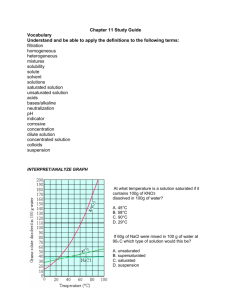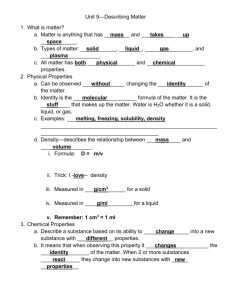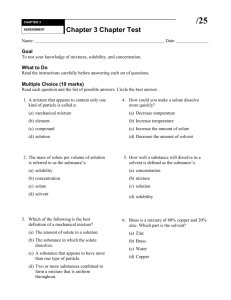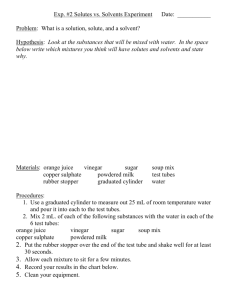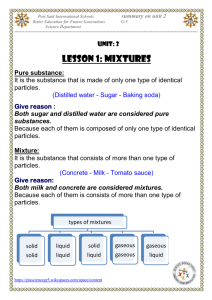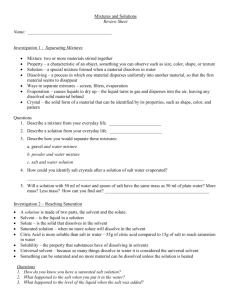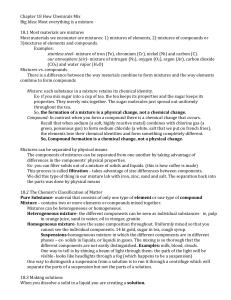Science 14 Unit A Review
advertisement
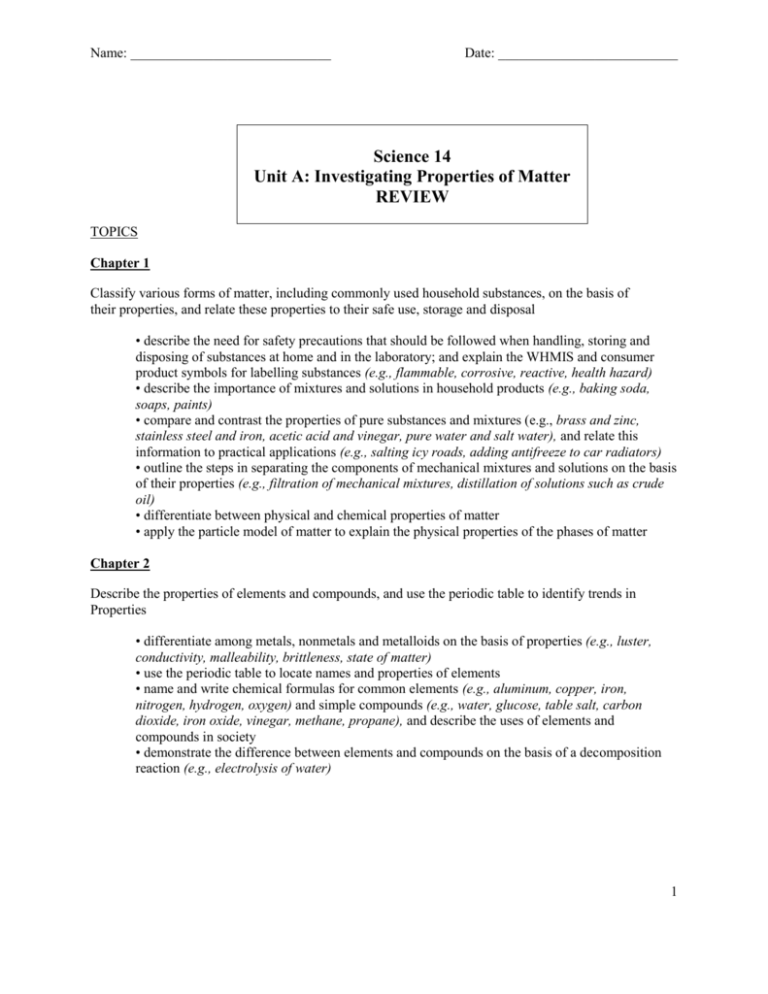
Name: _____________________________ Date: __________________________ Science 14 Unit A: Investigating Properties of Matter REVIEW TOPICS Chapter 1 Classify various forms of matter, including commonly used household substances, on the basis of their properties, and relate these properties to their safe use, storage and disposal • describe the need for safety precautions that should be followed when handling, storing and disposing of substances at home and in the laboratory; and explain the WHMIS and consumer product symbols for labelling substances (e.g., flammable, corrosive, reactive, health hazard) • describe the importance of mixtures and solutions in household products (e.g., baking soda, soaps, paints) • compare and contrast the properties of pure substances and mixtures (e.g., brass and zinc, stainless steel and iron, acetic acid and vinegar, pure water and salt water), and relate this information to practical applications (e.g., salting icy roads, adding antifreeze to car radiators) • outline the steps in separating the components of mechanical mixtures and solutions on the basis of their properties (e.g., filtration of mechanical mixtures, distillation of solutions such as crude oil) • differentiate between physical and chemical properties of matter • apply the particle model of matter to explain the physical properties of the phases of matter Chapter 2 Describe the properties of elements and compounds, and use the periodic table to identify trends in Properties • differentiate among metals, nonmetals and metalloids on the basis of properties (e.g., luster, conductivity, malleability, brittleness, state of matter) • use the periodic table to locate names and properties of elements • name and write chemical formulas for common elements (e.g., aluminum, copper, iron, nitrogen, hydrogen, oxygen) and simple compounds (e.g., water, glucose, table salt, carbon dioxide, iron oxide, vinegar, methane, propane), and describe the uses of elements and compounds in society • demonstrate the difference between elements and compounds on the basis of a decomposition reaction (e.g., electrolysis of water) 1 Name: _____________________________ Date: __________________________ Chapter 3 Describe solutions and solubility, solutes and solvents; and then describe how these concepts are applied to the production of prepared foods and other useful materials • provide examples of insoluble and soluble mixtures (e.g., oil and water, vinegar and water); and, in general terms, account for the difference • define, operationally, solute, solvent, solution and solubility; and express concentration in terms of mass per volume • provide examples of the effect of temperature change on solubility, and explain this effect on the basis of the particle model of matter (e.g., concentration of brines for pickling and syrups for canning) • link concentration changes and the concept of dilution to changes in the ratio of the amount of solute to the amount of solvent (e.g., investigate how concentrated products, such as orange juice, evaporated milk or instant coffee are made) Chapter 4 Describe solutions and solubility, solutes and solvents; and then describe how these concepts are applied to the production of prepared foods and other useful materials • compare the volume of waste packaging produced from consumer use of the concentrated and diluted forms of products (e.g., orange juice, fabric softener), and relate this to the need for recycling and environmental preservation • identify acid and base solutions in the home, job site and laboratory (e.g., vinegar, soda pop, shampoo, battery acid, household ammonia, antacids, dish soap, hydrochloric acid, sodium hydroxide) on the basis of their general properties; i.e., they conduct electricity, change colour of acid/base indicators and neutralize one another • describe, in general terms, the pH scale as an indicator of acidity or basicity; i.e., a pH of less than 7 indicates an acid, a pH of 7 indicates a neutral solution, and a pH of greater than 7 indicates a base • describe and investigate the corrosive effects of the following environmental factors: acids, bases, salts, humidity and temperature (e.g., corrosion of iron by acid rain and spray from ocean water) • list the potential dangers of mixing common household and industrial chemicals (e.g., mixing ammonia cleaners with bleach, adding muriatic [hydrochloric] acid to caustic soda, adding water to acid) 2 Name: _____________________________ Date: __________________________ KEY TERMS Chapter 1 WHMIS MSDS HHPS Matter Theory Particle theory of matter States of matter Solid Liquid Gas Physical property Chemical property Pure substance Mixture Chapter 2 Element Periodic table Atom Group Period Metal Non-metal Metalloids Compound Decomposition reaction Element symbol Chemical formula Chapter 3 Mechanical mixture Solution Solute Solvent Concentration Solubility Soluble Crystallization distillation Chapter 4 Concentrated Dilute Acid Base Neutral Indicator Litmus paper pH pH scale neutralization corrosive corrosion acid rain SAMPLE QUESTIONS A. Definitions – define ALL the terms on a sheet leaf from the above chart B. Short Answer: 1. List 3 pieces of info found on a MSDS sheet. 2. Why might a useful chemical also be dangerous? 3. Give three examples of hazardous chemicals often found in the home. 4. What does the position of neon in the periodic table tell you about its properties? List three properties. 5. Classify each of the following as either a metal or non-metal. a) b) c) d) e) Greenish-yellow gas Silver-coloured solid that conducts electricity Grayish solid that is shiny when sanded Very brittle brown crystal Very shiny silver-coloured liquid that conducts electricity 6. What is the difference between an element and a compound? 7. How can a decomposition reaction help you determine whether a pure substance is an element or a compound? 3 Name: _____________________________ Date: __________________________ 8. What would happen if you tried to decompose and element? Why? 9. What information about a substance does a chemical formula represent? 10. Write the chemical formula for a compound that is made up of one atom of nitrogen and two atoms of oxygen. 11. Classify each of the following as a mechanical mixture or a solution. a) b) c) d) e) Concrete Shampoo Air Tap water Cookie dough 12. Describe two tests you can use to determine if a mixture is a solution or a mechanical mixture. 13. In each of the following solutions, identify the solute and solvent(s). a) b) c) d) Salt water Baking soda and water Air (78% nitrogen, 22% oxygen and other gases) Gold jewellery (90% gold, 10% silver) 14. Define a pure substance. Provide 2 examples. 15. Name 3 physical properties and 3 chemical properties 16. Describe the three states of matter and provide an example of each 17. Define heterogeneous mixture (mechanical mixture) and give 2 examples. 18. What does concentration tell you about a substance? 19. List some substances that are insoluble in water. 20. Describe how you could make a solute more soluble. 21. Define “solubility.” 22. Explain how crystallization could be used to separate drink crystals from juice. 23. List the steps in making water safe to drink. 24. Define “distillation.” 4 Name: _____________________________ Date: __________________________ 25. How could you make a solute dissolve more quickly? 26. Do most solutes dissolve better in warm water or in cold water? Explain why. 27. Describe how to make a dilute solution from a concentrated solution. 28. State two advantages of buying concentrated products rather than dilute products. 29. List three properties of acids. 30. An unknown solution was tested with litmus paper. The litmus paper turned blue. Is the substance an acid or a base? 31. Classify the following solutions as acids, bases or neutral. a) b) c) d) Household bleach, pH 12.4 Black coffee, pH 5.0 Sugar water, pH 7 Egg white, pH 7.8 32. List four factors that affect corrosion. 33. Explain the relationship between acids and corrosion. 34. Define “neutralization.” 35. Explain how rust is an example of corrosion. C. Multiple Choice Anything from the Chapter Tests! 5
